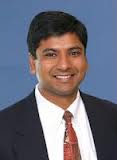NetApp, Inc. is a proprietary computer storage and data management company headquartered in Sunnyvale, California. NetApp creates innovative products – storage systems and software that help customers around the world store, manage, protect, and retain one of their most precious corporate assets: their data.
Manish Goel, executive vice-president, product applications at NetApp spoke to Ashwin Gopinath about the way the data growth is leading to newer and smarter methods in storage solutions.

Q. Please give us a brief overview of NetApp?
A. NetApp is a storage solution provider. It’s a $6.5 billion company employing over 12,000 people globally. We provide computer storage solutions to the major enterprises and governments across the globe.
Q. What kind of work is your R&D team involved in?
A. We have a global development model; we have 10 engineering sites across the globe, all of which work on all the projects equally. India is our largest engineering site at this point in time; 40 per cent of our workforce resides in Bengaluru and they are involved across the board in every single aspect of our engineering work.
Q. What kind of challenges do you face in this domain?
A. Storage is a critical part in data infrastructure. These days, it is as integral a part as any other in how most companies look to meet their business priorities. Data, as such, has two challenges viz. unprecedented data growth and, from an IT standpoint, the intense cost-budget pressures. The IT organisations are looking for ways to store their data and get the value out of that data in a way that’s cost effective, flexible and meets their business priorities.
Q. So what are the biggest trends with respect to data centres right now?
A. The biggest trend in the data centres right now is that they are transitioning from being application-oriented silos to becoming infrastructures where multiple applications and multiple data storage units can reside on the same infrastructure. This trend is causing people to re-architect their IT data centres and move to approaches which are much more flexible and agile as their data infrastructure needs to become a kind which is seamlessly scalable, theoretically being infinite in its capacity to scale. It has to be immortal in its ability to store data for a really long time regardless of the underlying hardware life cycles. It also needs to be really intelligent as in it stores the data in the right hardware architecture so that the cost sensitive data is residing in the cost-sensitive hardware architecture and the performance sensitive data is residing in the performance sensitive architecture. All of this needs to be done completely automatically and must be handled by the storage architecture itself.
Q. What challenges has this humongous increase in data brought forth?
A. There is no doubt that the scale of data has become so large that the traditional approaches of managing that data are becoming completely outdated. So essentially when you’re managing petabytes to exabytes of data, a lot of tasks where human administration was possible, now human involvement is NOT possible because of the sheer size involved and hence, that management has to be done by the underlying infrastructure itself. Whether it is storing the data in its right price point, in the right tier or the ability to protect that data from disaster(s) or something similar, the corrective as well as preventive measures have to be taken up by the system. Today, there is a clear focus on working out how to convert this data into business value and hence, a lot of emphasis is placed on data analysis.
Q. So, how does differentiation happen within competitors in this market?
A. The approach we have taken for our development site over here is that it is absolutely a full-fledged product innovation site. That was a conscious decision we made the day we opened our site here. Many companies, when they have opened their operations in India have taken an approach where they have put lower quality or lower value work to India first and there has been a tearing of the kind of work that takes place between the different development sites. We made a conscious decision to have India be a full-fledged part of our product innovation agenda. With any product that we develop, our Indian engineers work side-by-side with their US counterparts for developing that product. So, if you’re a systems engineer, this is a really exciting place to be. This is where hard-core engineering takes place. We hire the best and the brightest. We have continuously been a great place to work at. Our work culture and the kind of work we do is something we are very proud of.






